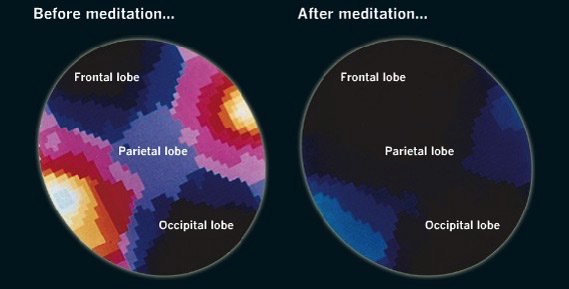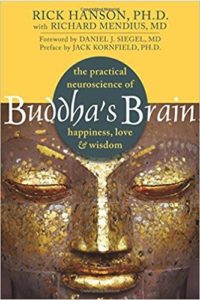
“Praying is talking to the Universe. Meditation is listening to it” – Paul Coelho
Meditation is a life-changing practice with benefits that are backed by over 3000 scientific studies. These include decreased anxiety and stress levels, increased resilience, energy, focus and memory, increased gray matter in the brain, increased compassion, increased joy and overall better health. And, a documented serotonin boost that helps ease the pain of just about anything.
If you could learn simple ways to actively change your brain and be happier every day, why wouldn’t you do it?
 Humans have been actively meditating for thousands of years; now, research has figured out what keeps us coming back for more. Meditation engages a part of the body known as the parasympathetic nervous system, or PNS. This system slows our heart rate and helps our bodies recover from stress. Meditation also quiets down the part of our brain known as the frontal lobe, which is responsible for reasoning, planning, emotions and self-conscious awareness.
Humans have been actively meditating for thousands of years; now, research has figured out what keeps us coming back for more. Meditation engages a part of the body known as the parasympathetic nervous system, or PNS. This system slows our heart rate and helps our bodies recover from stress. Meditation also quiets down the part of our brain known as the frontal lobe, which is responsible for reasoning, planning, emotions and self-conscious awareness.
In other words, meditation can significantly neutralize challenging emotions, quiet your mind and make you feel a lot better about everything.
Like anything else, you’ll get the most out of practices that resonate with you and make the most sense in your life. Meditation is also very fluid, and what works for you can change over time. Most important to know is that with any type of meditation, there is never any “right or wrong,” which is why it is called a practice.
Below are a few approaches that have become my personal favorites. Please note that guidance is always helpful, whether through retreats, books, video, apps or recordings… your way to wellness is just a few breaths away.
- Vipassana: Translation, “Insight Meditation,” this traditional Buddhist path is described as when “mindfulness of breathing and of thoughts, feelings and actions are being used to gain insight into the true nature of reality.” In plain English, you sit on a cushion or chair and begin focusing on (and coming back to) your breath. Initial breath work leads to a disciplined observation of the sense gates (body, image and talk), the continual interplay among them, and how all experience is processed through them. My experience has been that Vipassana leads to significant insight and growth. It is extremely powerful and effective. It can also be quite challenging, but well worth the effort.
 Mindfulness: (A.K.A awareness) and breath meditation are very much intertwined. Mindfulness is a form of meditation that is cultivated by meditating. In all kinds of meditation, we practice sustained and focused awareness on something – whether that something is our breath or our senses, the more we “practice” sustained attention, the more “mindful” and present we become when we are not meditating.Mindfulness Based Stress Reduction, or MBSR was founded by Dr. Jon Kabat-Zinn, an internationally known meditation teacher, author, researcher and clinician in the fields of mind/body medicine and self-healing. His work is offered by over 720 medical centers, hospitals, and clinics around the world. It has also been adopted by companies like GE, Google and General Mills.Dr. Kabat-Zinn further explains mindfulness this way:
Mindfulness: (A.K.A awareness) and breath meditation are very much intertwined. Mindfulness is a form of meditation that is cultivated by meditating. In all kinds of meditation, we practice sustained and focused awareness on something – whether that something is our breath or our senses, the more we “practice” sustained attention, the more “mindful” and present we become when we are not meditating.Mindfulness Based Stress Reduction, or MBSR was founded by Dr. Jon Kabat-Zinn, an internationally known meditation teacher, author, researcher and clinician in the fields of mind/body medicine and self-healing. His work is offered by over 720 medical centers, hospitals, and clinics around the world. It has also been adopted by companies like GE, Google and General Mills.Dr. Kabat-Zinn further explains mindfulness this way:
• Paying attention in systematic ways that change brain structure to enhance well-being, clarity and intelligence
• Living life as if it really matters
• Not a way of “doing” but a way of “being” awake in each moment, feeling our lives unfolding in our bodies as opposed to heads
• Helps us regulate the way we react to life by not running away or pushing things away; rather, letting them unfold.- “Taking in the Good” – Rick Hanson, renowned neuropsychologist and bestselling author, “Buddha’s Brain, Hardwiring Happiness”
 It’s true – we have over 65,000 thoughts per day – and, according to research, up to 75% of them are negative. According to Dr. Hanson, our brains evolved a negativity bias in order to survive. The good news is that the brain and mind are one “system” – and because the brain is neuroplastic, we can use our minds to change our brains, decrease our stress response and increase feeling well.To do this, Dr. Hanson has come up with what he calls, “Taking in the good.” This translates to giving sustained attention to positive experiences – whether this means smelling a flower, getting a hug, or any experience that fosters happiness, the trick is staying with it for 20 or 30 seconds; the amount of time it takes to create a new neural pathway in our brain, forged in positive experience. I’m a huge Rick Hanson fan – in fact, I was honored to tell his story in my Soul Models book. Since then, I’ve shared his work with just about anyone who will listen – it’s so simple and super effective.
It’s true – we have over 65,000 thoughts per day – and, according to research, up to 75% of them are negative. According to Dr. Hanson, our brains evolved a negativity bias in order to survive. The good news is that the brain and mind are one “system” – and because the brain is neuroplastic, we can use our minds to change our brains, decrease our stress response and increase feeling well.To do this, Dr. Hanson has come up with what he calls, “Taking in the good.” This translates to giving sustained attention to positive experiences – whether this means smelling a flower, getting a hug, or any experience that fosters happiness, the trick is staying with it for 20 or 30 seconds; the amount of time it takes to create a new neural pathway in our brain, forged in positive experience. I’m a huge Rick Hanson fan – in fact, I was honored to tell his story in my Soul Models book. Since then, I’ve shared his work with just about anyone who will listen – it’s so simple and super effective.
Dr. Hanson has proven that our we can re-train our brains to default to more positive thoughts. In the same way, I also believe we can train our brains to default to more creative states. Whether we’d like to be more positive, more creative, or both, meditation is key to getting there, and the possibilities are endless. And, if you check out the resources below, both Drs. Hanson and Kabat-Zin offer some incredible audio e-books and downloads to help you jump on the meditative path.
I’m hopeful that someday all kinds of meditation and mindfulness will be taught as part of our regular educational curriculum. I truly believe if this were the case, the world would be an entirely better place.
Meanwhile, below are some great resources to start you off on your meditation and mindfulness journey: gift yourself with just ten minutes a day of any of these, and watch your life transform.
RESOURCES:
Benefits of Meditation
Guided Mindfulness Meditations
Rick Hanson
Shinzen.org
Mindfulness Based Stress Reduction
Train Your Brain
“Praying is talking to the Universe. Meditation is listening to it” – Paul Coelho
Meditation is a life-changing practice with benefits that are backed by over 3000 scientific studies. These include decreased anxiety and stress levels, increased resilience, energy, focus and memory, increased gray matter in the brain, increased compassion, increased joy and overall better health. And, a documented serotonin boost that helps ease the pain of just about anything.

If you could learn simple ways to actively change your brain and be happier every day, why wouldn’t you do it?
Humans have been actively meditating for thousands of years; now, research has figured out what keeps us coming back for more. Meditation engages a part of the body known as the parasympathetic nervous system, or PNS. This system slows our heart rate and helps our bodies recover from stress. Meditation also quiets down the part of our brain known as the frontal lobe, which is responsible for reasoning, planning, emotions and self-conscious awareness.

In other words, meditation can significantly neutralize challenging emotions, quiet your mind and make you feel a lot better about everything.
Like anything else, you’ll get the most out of practices that resonate with you and make the most sense in your life. Meditation is also very fluid, and what works for you can change over time. Most important to know is that with any type of meditation, there is never any “right or wrong,” which is why it is called a practice.
Below are a few approaches that have become my personal favorites. Please note that guidance is always helpful, whether through retreats, books, video, apps or recordings… your way to wellness is just a few breaths away.
- Vipassana: Translation, “Insight Meditation,” this traditional Buddhist path is described as when “mindfulness of breathing and of thoughts, feelings and actions are being used to gain insight into the true nature of reality.” In plain English, you sit on a cushion or chair and begin focusing on (and coming back to) your breath. Initial breath work leads to a disciplined observation of the sense gates (body, image and talk), the continual interplay among them, and how all experience is processed through them. My experience has been that Vipassana leads to significant insight and growth. It is extremely powerful and effective. It can also be quite challenging, but well worth the effort.
 Mindfulness: (A.K.A awareness) and breath meditation are very much intertwined. Mindfulness is a form of meditation that is cultivated by meditating. In all kinds of meditation, we practice sustained and focused awareness on something – whether that something is our breath or our senses, the more we “practice” sustained attention, the more “mindful” and present we become when we are not meditating.Mindfulness Based Stress Reduction, or MBSR was founded by Dr. Jon Kabat-Zinn, an internationally known meditation teacher, author, researcher and clinician in the fields of mind/body medicine and self-healing. His work is offered by over 720 medical centers, hospitals, and clinics around the world. It has also been adopted by companies like GE, Google and General Mills.Dr. Kabat-Zinn further explains mindfulness this way:
Mindfulness: (A.K.A awareness) and breath meditation are very much intertwined. Mindfulness is a form of meditation that is cultivated by meditating. In all kinds of meditation, we practice sustained and focused awareness on something – whether that something is our breath or our senses, the more we “practice” sustained attention, the more “mindful” and present we become when we are not meditating.Mindfulness Based Stress Reduction, or MBSR was founded by Dr. Jon Kabat-Zinn, an internationally known meditation teacher, author, researcher and clinician in the fields of mind/body medicine and self-healing. His work is offered by over 720 medical centers, hospitals, and clinics around the world. It has also been adopted by companies like GE, Google and General Mills.Dr. Kabat-Zinn further explains mindfulness this way:
• Paying attention in systematic ways that change brain structure to enhance well-being, clarity and intelligence
• Living life as if it really matters
• Not a way of “doing” but a way of “being” awake in each moment, feeling our lives unfolding in our bodies as opposed to heads
• Helps us regulate the way we react to life by not running away or pushing things away; rather, letting them unfold.- “Taking in the Good” – Rick Hanson, renowned neuropsychologist and bestselling author, “Buddha’s Brain, Hardwiring Happiness”
 It’s true – we have over 65,000 thoughts per day – and, according to research, up to 75% of them are negative. According to Dr. Hanson, our brains evolved a negativity bias in order to survive. The good news is that the brain and mind are one “system” – and because the brain is neuroplastic, we can use our minds to change our brains, decrease our stress response and increase feeling well.To do this, Dr. Hanson has come up with what he calls, “Taking in the good.” This translates to giving sustained attention to positive experiences – whether this means smelling a flower, getting a hug, or any experience that fosters happiness, the trick is staying with it for 20 or 30 seconds; the amount of time it takes to create a new neural pathway in our brain, forged in positive experience. I’m a huge Rick Hanson fan – in fact, I was honored to tell his story in my Soul Models book. Since then, I’ve shared his work with just about anyone who will listen – it’s so simple and super effective.
It’s true – we have over 65,000 thoughts per day – and, according to research, up to 75% of them are negative. According to Dr. Hanson, our brains evolved a negativity bias in order to survive. The good news is that the brain and mind are one “system” – and because the brain is neuroplastic, we can use our minds to change our brains, decrease our stress response and increase feeling well.To do this, Dr. Hanson has come up with what he calls, “Taking in the good.” This translates to giving sustained attention to positive experiences – whether this means smelling a flower, getting a hug, or any experience that fosters happiness, the trick is staying with it for 20 or 30 seconds; the amount of time it takes to create a new neural pathway in our brain, forged in positive experience. I’m a huge Rick Hanson fan – in fact, I was honored to tell his story in my Soul Models book. Since then, I’ve shared his work with just about anyone who will listen – it’s so simple and super effective.
Dr. Hanson has proven that our we can re-train our brains to default to more positive thoughts. In the same way, I also believe we can train our brains to default to more creative states. Whether we’d like to be more positive, more creative, or both, meditation is key to getting there, and the possibilities are endless. And, if you check out the resources below, both Drs. Hanson and Kabat-Zin offer some incredible audio e-books and downloads to help you jump on the meditative path.
I’m hopeful that someday all kinds of meditation and mindfulness will be taught as part of our regular educational curriculum. I truly believe if this were the case, the world would be an entirely better place.
Meanwhile, below are some great resources to start you off on your meditation and mindfulness journey: gift yourself with just ten minutes a day of any of these, and watch your life transform.



